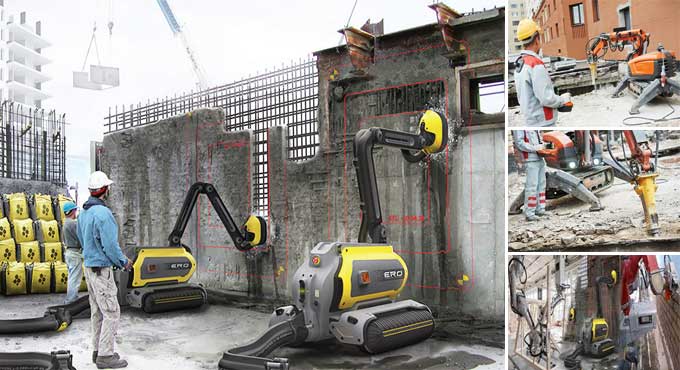
Role of Construction Robots in shaping the Construction industry
In recent times, the use of technology and robots has enhanced the overall workflow and also improved the quality of the overall project. Construction sites are becoming more automated and robotic with the arrival of robots and automated technology. Nowadays construction is less labour intensive, less wasteful, and environmentally friendly when they are used in the building industry.
What do you mean by Construction Robots?
Construction robots are devices made to automate a variety of operations that would otherwise be done by human employees in the sector. They often use advanced sensors and preprogrammed algorithms to do predefined tasks including lifting, hauling, welding, and other activities.
The construction business has undergone a transformation because of these marvels of contemporary technology, which have enhanced productivity, reduced costs, and improved safety.
What is the workflow of construction robots?
The construction industry is becoming increasingly dependent on robots. In addition to cutting and welding, they can also excavate and lay foundations on job sites autonomously. A combination of artificial intelligence, machine learning, and sensors enables these robots to perform their tasks with greater accuracy, efficiency, and safety than human workers.
What are construction robots used for?
The construction industry has undergone a revolution in recent years, as construction robots are more precise, safe, and efficient than manual methods. Various tasks are performed by construction robots, including surveying, 3D scanning, welding, drilling, and assembling structures.
Three-dimensional scanning and surveying are some of the most common uses of construction robots, which are often used to model construction sites and buildings before or during construction. With this technology, structures can be measured and surveyed more precisely, which allows for faster, more accurate design and planning.
Welding and drilling are also performed by robots, eliminating the need for manual labour. The precision of fasteners and welds is improved as a result of reducing human error potential.
Some robots can lift and carry pallets of supplies up to five times quicker than manual labour, and they are also employed to move items around construction sites. This aids in accelerating and streamlining the building process while lowering the number of man-hours needed to finish a project.
Other uses
Brick laying and assembly of entire structures are also increasingly being carried out by robots. Additionally, this eliminates the need for manual labour and improves the accuracy and consistency of bricklaying and structure assembly.
For demolition purposes, robots are being used, allowing for the precise and safe removal of structures and materials. As a result, demolition processes produce less dust, debris, and waste, thereby reducing the possibility of workers being injured.
Future Implications of construction robots for the future
Several implications are associated with the rapid development of robots in the construction industry. The advent of construction robots could revolutionize the industry by reducing labour costs, improving safety, and reducing project costs.
At the same time, robots in construction can also increase the demand for skilled labour, such as engineers and technicians, to operate, maintain, and repair the robots. Moreover, robots can increase the accuracy of construction tasks, improving the quality of the project and helping to reduce construction costs.
Using robots to reduce manual labour may have a significant impact on the availability of labour in the construction sector. In order to lessen the impact of robotics on construction jobs, existing workers might have to be retrained for more specialized roles.
The use of robots may have a significant influence on safety. Robots can perform tasks that would be too risky or challenging for humans, such as working at heights or in dangerous locations. This might reduce mishaps and injuries on job sites, making construction employment more appealing and safe.
Site Preparation
The most important steps in construction are site preparation and surveying. To ensure accuracy and safety, this step typically requires significant labour and expertise. It is possible, however, that construction robots will revolutionize the process. In addition to reducing labour and time costs, robotic solutions can optimize and improve site preparation and surveying.
Carpentry work with robots
The work of carpentry can also be done more efficiently with the use of robots. The use of robots will enable you to make accurate measurements and make a complex and beautiful shape for your wood.
These robots could swiftly and effectively carve intricate forms and joinery, doing so without the aid of human labour. Robotic carpentry has the potential to save the construction industry a lot of time and money by lowering the amount of time needed to finish a job.
3D printing for construction
A 3D printer creates three-dimensional structures by sequentially layering construction materials. Additive Manufacturing (AM) is another term for 3D printing. Using specialized 3D printers, 3D printing is used in construction.
Artificial intelligence (AI) and computer programming control 3D printers for construction. CAD models are read through advanced construction robotics technology, which 3D prints the structure according to the models by layering the materials.
Robotic roofing
Increasing efficiency and reducing labour costs are among the benefits of robotic roofing as construction technology advances. It is much faster and more efficient to roof a building using robotic roofing machines than with traditional methods since they grapple and place roofing tiles. It is also possible to program these robots to adhere to certain roofing specifications and to fit different roofing styles and shapes.
In addition to monitoring roof systems for potential damage or issues, robotic roofing machines can also be used to maintain roofs for longer periods. The advantages of robotic roofing will revolutionize the construction industry by creating a simpler and more efficient way to build and maintain roofs.
Final Thoughts
There are great implications for the future of the construction industry with the advent of construction robots, and there are exciting possibilities. For the industry to be prepared for the future, it is important to consider the implications of construction robots.
To get more details, watch the following video tutorial.
Video Source: TopTechTopic


